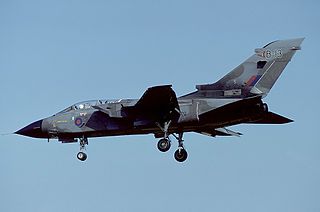Related Research Articles

Royal Air Force Station Cottesmore or more simply RAF Cottesmore is a former Royal Air Force station in Rutland, England, situated between Cottesmore and Market Overton. On 15 December 2009, Defence Secretary Bob Ainsworth announced that the station would close in 2013 as part of defence spending cuts, along with the retirement of the Harrier GR9 and the disbandment of Joint Force Harrier. The formal closing ceremony took place on 31 March 2011, and the airfield became a satellite of RAF Wittering until March 2012.

Royal Air Force Leconfield or more simply RAF Leconfield is a former Royal Air Force station located in Leconfield, East Riding of Yorkshire, England.

Royal Air Force Finningley or RAF Finningley was a Royal Flying Corps and Royal Air Force station at Finningley, in the Metropolitan Borough of Doncaster, South Yorkshire, England. The station straddled the historic county boundaries of both Nottinghamshire and the West Riding of Yorkshire.

Canadian Forces Base Greenwood, or CFB Greenwood, is a Canadian Forces Base located 1.5 nautical miles east of Greenwood, Nova Scotia. It is primarily operated as an air force base by the Royal Canadian Air Force and is one of two bases in the country using the CP-140 Aurora and CP-140A Arcturus anti-submarine/maritime patrol and surveillance aircraft. Its primary RCAF lodger unit is 14 Wing, commonly referred to as 14 Wing Greenwood.

Royal Air Force Croughton or more simply RAF Croughton is a Royal Air Force station which is currently a United States Air Force communications station in Northamptonshire, England. It is southeast of the village of Croughton. The station is home to the 422nd Air Base Group and operates one of Europe's largest military switchboards and processes approximately a third of all U.S. military communications in Europe.

Royal Air Force Gaydon or more simply RAF Gaydon is a former Royal Air Force station located 5.2 miles (8.4 km) east of Wellesbourne, Warwickshire and 10.8 miles (17.4 km) north west of Banbury, Oxfordshire, England.
No. 231 Operational Conversion Unit was a Royal Air Force Operational conversion unit.

Royal Air Force Bassingbourn or more simply RAF Bassingbourn is a former Royal Air Force station located in Cambridgeshire approximately 3 mi (5 km) north of Royston, Hertfordshire and 11 mi (18 km) south west of Cambridge, Cambridgeshire, England.
Royal Air Force Thornaby or more simply RAF Thornaby was a former Royal Air Force Station located near the town of Thornaby-on-Tees, in the North Riding of Yorkshire, England. Fighter Command, Bomber Command and Coastal Command all operated from the base over its history, but its stint under Coastal Command is what the base was notable for, particularly in the air-sea rescue environment and the development of the Thornaby Bag. This was an emergency bag dropped to downed aircrew at sea and contained food, cigarettes and drink.
Number 76 Squadron was a squadron of the Royal Air Force. It was formed during World War I as a home defence fighter squadron and in its second incarnation during World War II flew as a bomber squadron, first as an operational training unit and later as an active bomber squadron. With the end of the war the squadron converted to the role of transport squadron, to be reactivated shortly in the bomber role during the 1950s. From 2007 to 2011, it was a training unit, equipped with the Short Tucano at RAF Linton-on-Ouse.
Number 58 Squadron was a squadron of the Royal Air Force.
Royal Air Force Catfoss or more simply RAF Catfoss is a former Royal Air Force station during the Second World War. It was located 4 miles (6.4 km) west of Hornsea, Yorkshire, England and 8 miles (13 km) north-east of Leconfield, Yorkshire, with the nearest village being Brandesburton.
No. 108 Squadron RAF was originally a squadron of the Royal Flying Corps during World War I which continued to serve with the Royal Air Force in World War II.

No. 166 Squadron RAF was a Royal Air Force squadron that formed just after the end of World War I. It was the first and one of only three to be equipped with the Handley Page V/1500 heavy bomber.
No. 234 Squadron RAF had a long career within the RAF, being operational on flying boats in World War I and on fighter aircraft in World War II. After the war it remained a fighter unit till 1957. In its last incarnation the squadron was in turn Operational Training Unit (OTU), Tactical Weapon Unit (TWU) and part of No. 4 Flying Training School RAF until finally disbanded in 1994.

RAF Warboys is a former Royal Air Force heavy bomber station, situated just outside the village of Warboys in Huntingdonshire.

No. 10 Operational Training Unit RAF or more simply No. 10 OTU was a training unit operated by the Royal Air Force.

RAF Upper Heyford was a Royal Air Force station located 5 miles (8 km) north-west of Bicester near the village of Upper Heyford, Oxfordshire, England. In the Second World War the airfield was used by Bomber Command. During the Cold War, Upper Heyford was one of the former RAF bases chosen to house the United States Air Force Strategic Air Command (SAC) nuclear-capable bombers on 90-day TDY deployments until 1959, SAC Reflex Alert deployments from 1959 until 1965, from 1966 United States Air Forces in Europe (USAFE) tactical reconnaissance aircraft, and from 1970 F-111 strike aircraft.
References
- 1 2 "16 Operational Training Unit (OTU) - RAF Upper Heyford, England". raf-upper-heyford.org. Retrieved 15 April 2015.
